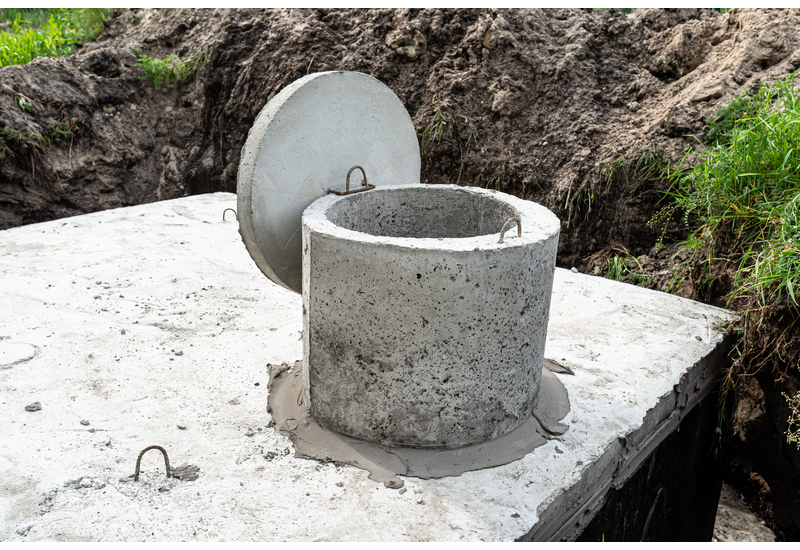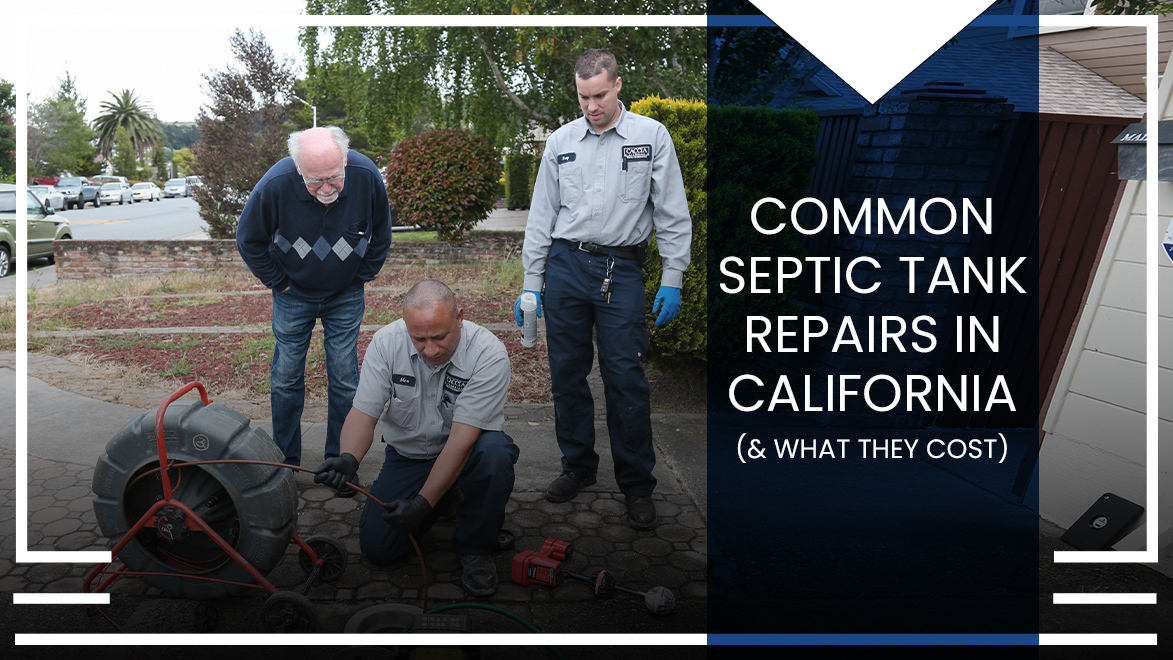Summary:
- Septic tanks play a critical role in managing wastewater on California properties that aren’t directly connected to municipal sewer lines. Regular maintenance and repairs can help keep your system in good working condition for up to 30 years or longer.
- In California, the costs associated with septic tank service calls can vary widely depending on the severity of the problem and how urgent it is. Getting an estimate for service is as easy as reaching out to a professional for help.
- Knowledge is half the battle! Understanding which septic tank repairs property owners usually face, and what you can expect to pay for a fix, can help you budget and plan for emergencies.
- If you suspect a problem with your septic tank, it’s important to reach out to a professional for help right away. A quick response often prevents a minor issue, such as a clog or leak, from affecting other parts of the system or your home.
Septic systems usually operate out of sight, out of mind—at least until something goes wrong. The first symptoms of a problem, including bad bathroom smells, leaks, or flooding, often crop up out of the blue or with very little warning, which can leave you scrambling for help. Knowing what different septic tank repairs can cost ahead of time can help you plan for the work you need.
Remember, every septic tank repair call is unique. Our experts always provide an estimate of upfront costs before tackling the job so you know exactly what to expect. While the prices in this guide reflect typical averages, your actual costs may vary based on the specifics of your situation.

Clogs
Septic tank clogs occur when materials that don’t break down easily clump up and block the free flow of wastewater through the system. Unlike a toilet that won’t flush, clearing the blockage is rarely as simple as reaching for the closest plunger. That’s because clogs can form within any point in the system: the inlet pipe, the tank itself, the outlet pipe, or the lateral line.
The symptoms of a clog may be minor or severe. Early warning signs include:
- Slow drains or flushing
- Flooding around the drain field or tank
- Bubbling or gurgling noises in plumbing
- A bad or “rotten egg” smell near the tank
A severe enough clog can even cause sewage and wastewater to back up into your home.
Learn More: Easy Ways to Find Your Septic Tank
Common Causes:
1. Flushing Non-Biodegradable Materials
- Only water, approved additives, human waste, or toilet tissue should enter your system.
- Flushing items like toys, plastic wrap, dental floss, or cigarette butts can trigger clogs.
2. Flushing Slow-To-Decay Materials.
- Baby wipes, feminine hygiene products, paper towels, and facial tissues break down very slowly.
- Even products that claim to be flushable or “septic safe” can still cause clogs.
3. Neglected Maintenance
- Regular maintenance helps keep your septic system healthy and efficient.
- Have your tank inspected for problems at least once per year.
- Most septic tanks will need to be pumped out every 3 to 5 years.
4. Tree Root Invasion
- Trees thrive on the nutrients found in sewage.
- Root systems will actively seek out and infiltrate plumbing if they sense nutrients nearby.
- Cracks or leaks in piping will attract roots, which may block plumbing completely.
5. Crushed or Broken Pipes
- Increased pressure from soil shifts or vehicles may crush or break plumbing pipes.
- Common symptoms include leaks or flooding, but crushed pipes may also halt flow.
Costs to Fix a Clog
For minor or partial clogs, you may be tempted to try chemical or biological additives that claim to break down waste or boost anaerobic bacteria in the tank. Wait! The science is still out on whether many of these products do more harm than good, so call us for a consultation first.
Related: Are Bio Drain Cleaners Safe for Your Plumbing?
In the table below, you’ll find the average price to fix a clog. Please note that individual service calls may vary based on the complexity of the job or materials used.

Leaks
Septic tank leaks can cause thousands of dollars of damage to your home or property. The fact that most wastewater contains raw sewage means they can also be extremely dangerous or even hazardous to your health as well as the environment.
Consequences of Untreated Leaks
- Indoor Leaks can cause serious water damage or structural issues. Excess moisture and dampness is an ideal breeding ground for mold, which can be expensive to fix.
- Leaks Within the Tank can cause your system to stagnate or fail, especially if your tank drains completely. The bacteria that are responsible for breaking down waste inside the tank need a certain amount of water to thrive. Without it, they will die off.
- Lateral Line Leaks can cause uneven drain field dispersal, flooding, or sewage backups. Unusually healthy grass above the line is one common symptom.
Severe or persistent leaks will eventually seep into the ground and spread, contaminating groundwater and damaging the local environment. In some cases, this may be construed as unlawful discharge of hazardous substance or sewage under Section 13271 of the California Water Code.
Common Causes
- Improper Maintenance. Prevention is worth a pound of cure! You can’t fix what you aren’t aware of, so don’t put off important maintenance tasks, like yearly inspections.
- Excess Water or Waste: Overloading your tank strains both the system itself and any plumbing connected to it, which may eventually lead to leaks. It’s critical to use a system that fits your needs.
- Broken or Degraded Plumbing. Over time, pipes, baffles, and lateral lines can crack, degrade, or break. Leaks that begin as tiny pinpoint holes will grow over time, resulting in failures, flooding, or total collapse along the same section.
- Broken or Cracked Tank: Shifts in the soil as a result of landscaping, earthquakes, tree root infiltration, or changes in the local water table can cause your tank to crack. The larger the break, the greater the leak.
Leaks should always result in a call to a professional. Our plumbing team has access to special equipment, including cameras, that can help pinpoint the problem and keep repair costs down.
Cost to Fix a Leak
The average cost to fix a leaking septic system depends on the size and scope of the leak itself as well as the type of septic system you have. Generally, the more difficult the problem area is to access, the more complicated it will be to diagnose and fix.
Response time may also influence your total costs for leak repair. Acting quickly the moment you suspect a leak can save you hundreds by preventing costly complications, such as water damage or contamination of local water sources.
The figures below represent the average cost for this service call. Your final pricing may be higher or lower depending on your situation.


Septic Tank Pumping
Most experts recommend having your septic tank pumped out and cleaned at least once every three to five years. Regular pumping can help prevent system overload, sewage backups, and clogs.
Pumping may also help resolve problems related to heightened pressure within the tank or lines, such as overflow or clogs. Excess wastewater can cause sewage gas to build up and escape back into your home or up through the soil. Left unaddressed, the pressure can eventually cause your tank to crack or trigger leaks along the lateral line.
What Happens During a Pumping Service Call
- Initial Inspection: A technician will assess your system in person and locate the septic tank itself. They’ll check the system for obvious problems and provide an estimate of associated costs for the call.
- Accessing the Tank: Opening the tank lid is the next step. The technician will run safety checks throughout this process to reduce the risk of spills or accidents.
- Vacuuming Out the Tank: Using a hose connected to a vacuum truck, the technician will remove all solid waste and liquid effluent from the inside of the tank. This is stored on our trucks for disposal after the call.
- Cleaning the Tank: The technician will use water—sometimes in tandem with hydro jets—to rinse out the inside of the tank and loosen any stuck debris. This is also vacuumed out until the tank is clean enough to inspect.
- Inspecting for Problems: Before closing the tank, the technician will closely inspect the inner workings, including any baffles, inlet pipes, or outlet pipes, for obvious signs of disrepair.
- Closing the Tank: The technician will close and properly seal the tank, cleaning up the area to ensure no mess is left behind.
- Findings & Recommendations: Before leaving, the technician will document their findings and recommend a pumping schedule based on the service call.
This isn’t the kind of task you can handle yourself at home! It can be dangerous and hazardous to your health or system—not to mention extremely messy—without the right equipment.
Cost to Pump Out a Septic Tank
The exact cost to have your septic tank pumped can vary depending on the nature of your service call and system. Generally, regular maintenance—including pumping or hydro jet cleaning—wil help save you money by preventing problems before they occur.
Learn More: Unclog Your Sewer Line With Caccia Plumbing
Factors that Influence the Final Cost
- The Size of Your Tank: Larger volumes may take longer to pump or be more complicated to service. Costs may be slightly higher to compensate.
- Repair Needs: If your technician identifies any leaks, clogs, or problems along the way, additional repairs may be necessary. This may increase your overall cost.
- Commercial Vs. Residential: Larger commercial systems that handle a higher volume of materials may need to be pumped more frequently. The presence of fats, oils and greases (FOGs) in food establishment systems can also complicate the service call.
Overall, you can expect to pay between $350 and $1,000 to have your septic tank pumped.
Tank Replacement
Replacing a septic tank or system entirely is usually considered a last resort for severe problems that cannot be resolved any other way. Modern systems are designed to last for around 30 years with proper maintenance. Many last even longer than that!
It’s important to note that nearly all of the parts on your septic system can be individually repaired or replaced. Even minor cracks to the tank can often be patched. Replacement is typically only recommended in specific situations.
When We Recommend Replacement
- Your Needs Have Changed: If your family has grown or you’re processing a higher volume of wastewater, you may need a larger system to keep up.
- Your System is Very Old: Septic tanks installed prior to 1980 may be inefficient and more prone to breakdowns. Sometimes, their design violates modern plumbing codes.
- You Constantly Need Repairs: All materials degrade slowly over time. If you find yourself frequently calling for septic tank repairs, your tank may be nearing the end of its lifespan.
- Your Tank is Broken or Cracked: Large breaks, cracks, or collapses are often impossible to patch or repair. Replacing the tank may be the only option.
If you aren’t sure whether this is the right approach for your system, give us a call for a consultation.
Cost to Replace a Septic Tank
Replacing a septic tank can feel like a significant investment, but it’s the type of expense that pays for itself over time. Newer systems are far more efficient at processing waste with less water.
If our experts recommend this service to you, it’s because they truly feel it is in your best interests or will help you achieve your goals. We’re happy to answer any questions you might have about costs.
Factors that Influence the Cost of Tank Replacement
- Site Accessibility: If your tank is difficult to access, it may cost more to replace.
- Tank Size: Larger tanks require more materials, and in some cases, heavier equipment.
- Local Regulations: Required permits or inspections may add to your final bill.
- Landscaping: Landscaping needs, including soil removal or replacement, may increase prices.
- System Upgrades: Upgrades like Grease Removal Devices (GRDs) may add to your bill.
The average cost to replace a septic tank typically falls between $10,000 and $20,000.
Contact Caccia for Septic Tank Repairs
Timely septic tank repairs keep your system working smoothly and save you from having to deal with more expensive headaches down the line. At Caccia Plumbing, we’re committed to transparency and fair pricing. That’s why we provide an upfront breakdown of costs before every service call.
Don’t let problems with your septic tank leave you scrambling—take the first step towards peace of mind and a worry-free system. Contact Caccia Plumbing online or call (650) 442-1470 for emergency service.



